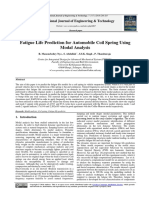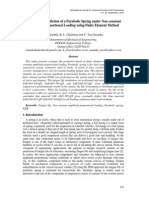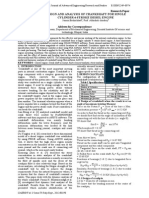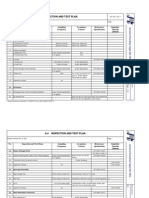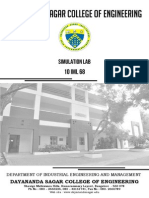60b7d5156166b47d4c PDF
60b7d5156166b47d4c PDF
Uploaded by
Ankush_1Copyright:
Available Formats
60b7d5156166b47d4c PDF
60b7d5156166b47d4c PDF
Uploaded by
Ankush_1Original Description:
Original Title
Copyright
Available Formats
Share this document
Did you find this document useful?
Is this content inappropriate?
Copyright:
Available Formats
60b7d5156166b47d4c PDF
60b7d5156166b47d4c PDF
Uploaded by
Ankush_1Copyright:
Available Formats
International Journal of Mechanical and Materials Engineering (IJMME), Vol.6 (2011), No.
3, 425-430
A FATIGUE ANALYSIS AND LIFE ESTIMATION OF CRANKSHAFT - A REVIEW R.M. Metkar1, V.K. Sunnapwar2 and S.D. Hiwase3
2
Department of Mechanical Engineering, Govt. College of Engineering, Amravati 444602, India Department of Mechanical Engineering, Lokmanya Tilak College of Engineering, Koperkhairane, Navi Mumbai, 444708, India. 3 Axis IT&T, Axis Aerospace Technology Hyderabad, 500005, India Email: rajeshmetkar@yahoo.co.in Received 2 July 2011, Accepted 12 December 2011
ABSTRACT The main objective of writing review on fatigue life of crankshaft is to investigate the behavior of crankshaft under complex loading conditions. Automobile industries are always interested to develop a new product which will be innovative and fulfill market expectations. All the engine components are subjected to constant to varying load which also varies in direction and due to these, components may fail. Bending and shear stress due to twisting are common stresses acting on crankshaft. Due to the repeated bending and twisting, crankshaft fails, as cracks form in fillet area. Hence, fatigue plays an important role in crankshaft development. Accurate prediction of fatigue life is very important to insure safety of components and its reliability. This review paper considers crankshaft as an important part of engine components, as forces which are acting on crankshaft are many and variable in nature. This paper presents an idea about research undertaken or completed on fatigue life of crankshaft, methods available and role of Finite Element Analysis (FEA) and experimental techniques used. Keywords: Finite Element Method, Crack Propagation, Crankshaft, Fatigue. 1. INTRODUCTION Crankshaft is an important component of internal combustion engine with complex geometry. Crankshaft experiences a large number of load cycle during its service life (Taylor and Ciepalowicz 1997) .The sudden failure of crankshaft made researchers and academia to investigate the problem. Because of complicated loading and geometry problem, general method to predict fatigue life is still not evolved. Since crankshaft is subjected to several force which vary in magnitude and direction (multiaxial) and connecting rod transmitting gas pressure from cylinder to crankpin, stresses acting in the crankshaft vary with respect to time (Montazersadgh and Fatemi, 2007) Most of time crankshaft fails due to fatigue at fillet areas due to bending load. Fillet rolling can increase fatigue life [Park et.al. 2001].Engine mechanism and geometry has large impact on fillet which experiences a large stress cycle during its working. Small crack initiates at this fillet location due to
stress concentration which will propagate subsequently and failure of crankshaft takes place. Most of the crankshafts that failed in fatigue were due to bending fatigue Design and Development has always an important issue in crankshaft production industry to manufacture less expensive crankshaft with high fatigue strength (Montazersadgh and Fatemi, 2007) 2. METHODS AVAILABLE Crankshaft is an important engine component which is subjected to fluctuating or cyclic loads often resulting in fatigue failures (Pun, 2001).Various methods are available and some are developed by researchers. Three methods which are used to predict fatigue life include stress life(SN), strain Life (E-N) and Linear Elastic Fracture Mechanics (LEFM). S-N method is based on nominal stress life using rainflow cycle counting. This method can be helpful to test fatigue life but only disadvantage is that plasticity effect is not considered and provides poor accuracy for low cycle fatigue (Solid work Corporation 2005).The strain life method provides more detailed analysis involving plastic deformation at a localized region and is useful for low cycle fatigue. Linear elastic fracture mechanics assume that crack is already available and detected and predicts crack growth by considering stress intensity factor. Because of easy implementation and various data available, stress life method is most commonly used where S-N curve data for particular material is commonly available. A new method called, cracks modeling, is developed by (Taylor and Ciepalowicz, 1997) to predict fatigue failure of crankshaft. This technique uses a Liner Elastic Finite Element Analysis to derive stress intensity factor for component under load. In this method, stress intensity factor is calculated without introducing a crack into a component; stress field around the maximum stress point is examined and compared to that of standard centre cracked plate. The material property is threshold stress intensity range. This research predicted the failure of crankshaft under constant amplitude loading. Failure occurs from stress concentration whose location is varied with loading type basically due to bending and torsion (Taylor, et al., 1999). In order to describe the severity of stress
425
concentration a crack modeling method is used (Taylor and Ciepalowicz, 1997). Other Method Known as Damaged Tolerance Analysis in which uses Linear Elastic Fracture Mechanics approach(LEFM) to predict the crack stability, crack growth, and hence minimal time between the two inspection to avoid a crack reaching critical size. The function of this method is to assess the effect of cracks in the structure. Damage tolerance is the ability to resist the fracture from pre existing crack in the given period of time to avoid catastrophic failure. (Paswan and Goel, 2008) Power Engineering Tool (PET) (Mikulec et al, 1998) developed by Ford Motor Company is a Graphics User Interface based computer model that calculate engine performance and the geometry at early stage of design. The Cranktrain development process is initiated by estimating required peak engine speeds for the peak engine power, cylinder bore diameter and piston stroke may be determined by using the combination of engine simulation results and empirical data of similar engine. By using this method, crankshaft system information such as number of cheeks per bay, number of main journal and crankpin etc can be found out. PET model easily generates initial geometry of complete power train system based on imputed engine configuration and design various parameters such as peak engine power, torque, and geometry constrain and Number of cylinders. High vibrations are playing important role in development of crack. A crankshaft system model (CRANKSYM) was used to verify the high vibration level in bearing cap. CRANKSYM is able to performed coupled analysis along with structural dynamics .It also calculates dynamic stresses on the crankshaft throughout whole engine cycle for which Finite Element model of complete assembly is required. This model gives output such as 3. MATERIAL FACTOR Material plays an important role in fatigue life of crankshaft. The steel alloy is typically used in high strength crankshaft, as it carries most desirable combinations properties (Kane, 2009). Due to cyclic loading, material behaves differently than under monotonic loading (Pun, 2001). Different types of cyclic material properties are required depending on the type of fatigue loading. Different alloy and surface treatment will increase fatigue life of crankshaft. (Park, et al. 2001) suggested that optimum level of nitriding depth should be at least 400 micrometer and because of nitriding fatigue limit is improved without any design modification. It is also proposed by (Park et al, 2001) that the best combination of crankshaft material with proper surface treatment can be used, which improves the quality and reduces the cost. Induction hardened crankshaft usually have longer fatigue life than other material (Taylor et al., 1999) Forge steel is commonly used as a crankshaft material because of requirement of higher horsepower per liter (Hoffmann and Turonek, 1992) while selecting material for
natural frequency, bearing load and axial displacement which is required for fatigue life estimation. (Mourelatos, 1995) suggested reducing flywheel inertia in order to increase the resonance frequency and second to balance the crankshaft internally in order to eliminate the unbalanced force on the flywheel. Crankshaft is also subjected higher loads at elevated temperature(Halaszi et al,1999), therefore thermo mechanical fatigue (TMF) life prediction has now commonly used in automotive industry as complex thermal and mechanical strains is used to find Fatigue life of engine component. Sehitoglu TMF Life prediction model developed by university of Illinois can be used to described the material behavior at different temperature and strain rate Fatigue Life can also determined by Principal Stress criterion by considering largest Principal stress (Mercer et al, 2003). Principal strain criterion considers largest principal strain and Von misses equivalent strain criterion provides an estimate of onset yielding behavior of material can also be used to predict fatigue life estimation. (Baxter, 1993) had studied the crack detection on crankshaft by using gel electrode techniques. In this experiment, at critical locations of crankshaft, a thin film of polymer film was applied and after fatigue test the surface was inspected with gel electrode probe. By using cathode and anode induced current flows at fatigue site and information is displayed as a direct image. AFGROW is one of the very good software available in the field of fatigue analysis and even very widely been used as well. Because of the complicated shape, size, topology and topography of crank shafts with several fillets and radius the use of AFGROW is showing the limitations on its application on crankshaft fatigue prediction. Hence, even not many references are also been sited on this subject. crankshaft cost, machinability and fatigue strength play important role. (Hoffmann and Turonek, 1992) studied two Chrysler corporation engines utilizing forge crankshaft. Six different grades of steel with different chemical composition were considered. To determine potential cost reduction, a computerized cost model for crankshaft was used to evaluate the economics of each material which is developed by Massachusetts Institute of Technology. Isotropic and anisotropic materials behave differently under multiaxial loading conditions (Liu and Mahadevan, 2000). They studied two different models for multiaxial fatigue life prediction of isotropic and anisotropic material. For isotropic material critical plane approach was used which depends on stress state and on material and fatigue fracture plane was determined. The multiaxial fatigue problem of anisotropic material is more complex as compared to other materials, hence fatigue failure of composite material are more complex than metal. Deep rolling of the fillet area is a significant surface treatment of an engine crankshaft by which the fatigue life of a crankshaft is increased by developing a compressive residual stress in fillet area (Ko et al, 2005)
426
4. EXPERIMENTAL TECHNIQUES (Paswan and Goel, 2008) investigated fatigue results of induction hardened and case hardened 6 cylinder Crankshaft .Stain gauges are placed in fillet area. Crankshaft is installed on fixture and clamp ring, cooler is used to prevent loosening. This fixture is attached to inertial weight and shaker and accelerometer. Due to shaker crankshaft acts as a tuning fork and arrangement is made such that if there is any failure in crankshaft, cycle stops automatically. After investigating twelve sample of crankshaft using this technique, author found no evidence of failure and predicted that induction hardened crankshaft has longer life than any other material. An investigation of a damaged crankshaft from a horizontal, six-cylinder, in-line diesel engine of a public bus was conducted by (Alfares et al. 2007) after several failure cases were reported by the bus company. All crankshafts were made from forged and nitriding steel. In Laboratory investigation the depth of the nitriding layer near fracture locations in the crankshaft, particularly at the fillet region where cracks were initiated, was determined by scanning electron microscope (SEM) equipped with electrondispersive X-ray analysis (EDAX) and was found less. Fractography which is the study of fracture surfaces of materials indicated that fatigue was the dominant mechanism of failure of the crankshaft. The partial absence of the nitriding layer in the fillet region, due to overgrinding, caused a decrease in the fatigue strength which, in turn, led to crack initiation and propagation, and eventually premature fracture. (Alfares et al. 2007) Jung et al. (2009) used ductile crankshaft which is commonly used for SUV and lightweight truck. A crankshaft is mounted on fixture and monotonic bending load and frequency was applied to front main bearing. A computer is used to monitor feedback signal when sample is under bending load. When crack initiates and propagates, displacement amplitude also increases also the feedback signal, computer automatically stop the process. After investigating the sample cracks are found initiates around fillet area and propagating rapidly causing failure. Yu et al. (2004) used resonance bending Fatigue test in order to investigate the effect of notch depth and subsequently the fatigue.SAE J434C D5506 cast iron crankshaft section were used in this investigation. Resonant frequency before and after creation of notches were measured. In the experimental set up crankshaft section was attached to heavy a steel tine which acts as tuning fork. The right tin is excited by shaker. During testing oil is applied to fillet area. For given bending moment excited by shaker probe, fatigue life is determined when four pin head sized bubble are formed, at this point test was suspended. For result validation a 3 dimensional Finite Element model of resonant bending system with notched crankshaft was
prepared and results of experimental techniques and by using FEM were found in good agreement. The other commonly used experimental method to test bending fatigue limit is Rotating bending fatigue test. In this constant bending stress is applied to round sample of crankshaft material along with rotation until its failure. This technique is simple and easy to use. Reciprocating Bending Testing Machines utilize a rotating crank to achieve a nonzero mean stress through positioning of the specimen with respect to the motor, whereas Direct Force Fatigue Testing Machines uses axial load. Staircase method is very commonly used in auto sector for crank shaft fatigue testing) and then apply a statistical analysis. In this initial stress amplitude based on experience is applied and sample is tested for survive or failure. When a survival (failure) occurs, the stress amplitude is increased (decreased) by one stress increment (step) for the next sample. Magnetic Particle Testing can be utilized on any ferromagnetic material in a variety of forms such as bars, engine components such as crankshaft for in-service discontinuities. Magnetic particle Testing (MT) is a nondestructive method which utilizes the flux leakage arising as a result of surface and near surface discontinuities to detect flaws. A Magnetic current or field is imposed on the part under inspection, a flux leakage at the surface of the part results in accumulation of sprayed iron powder, giving a direct indication of flaw. Ultrasonic Testing utilizes sound waves with a frequency greater than 20 kHz (inaudible to humans) to detect flaws and/ or material properties. Modern Ultrasonic Testing (UT) can be utilized for finding cracks, de-bonds and laminations; detecting macrostructure variations and anomalies; variations in physical dimensions; and for density, mass and elastic property determinations. Ultrasonic testing can be performed on metals, nonmetals and composites. The XRay machine or Gamma Radiation is the source of the rays and transmits penetrating X or Gamma Rays. The object being radiographed partially absorbs these rays. In areas where there are flaws or breaks, a greater or smaller number of rays are able to penetrate. Because X and Gamma Rays are invisible, a detecting agent is required to produce a visible picture. This detecting agent can be the radiographic film in light proof wrapping or a Digital image sensor. 5. FAILURE OF CRANKSHAFT (OTHER FACTORS ) Various other factors also play important role in mechanical fatigue failure of crankshaft, such as, misalignment of crankshaft on assembly , improper journal bearing, vibration due to some problem with main bearing or due to high stress concentration caused by incorrect fillet size, oil leakage, overloading, high operating oil temperature(Silva, 2003).Heat and stresses during contact bearing with repetition of heating and cooling would eventually create thermal fatigue cracks and it will propagate with time. (Kareem, 2007) generated the data gathered by oral
427
interviews and questionnaires on mechanical failures of crankshaft. The data collected were analyzed according to vehicle type using statistical methods. The results obtained showed that private cars enjoyed lowest fatigue failure rate at the initial stage while commercial buses had the highest fatigue failures rate. Vibration created due gas force which drives crankpin can be reduced by providing damper package (William Sisco). 6. APPLICATION OF FEM IN FATIGUE The use of numerical method such as Finite Element Method now a day commonly used to gives detail information about structure or component. This method predicts the behavior which is otherwise difficult to find out by theoretical calculation, as large number of degree of freedom involved in it. FEM can be used as excellent tool to analyze and find out fatigue life estimation of crankshaft by computer simulation and therefore it can help to reduce time and costs required for prototyping and to avoid numerous test series when laboratory testing is not available. Since loading on crankshaft is complex in nature, sophisticated analysis of crankshaft is required. Various Finite Element analysis tool such as MSC-Fatigue, ANSYS, FEMFAT etc are commonly used now a days by automobile companies to check durability of their products. Renault Company (Henry et al, 1992) developed a new crankshaft durability assessment tool based on 3D mesh, with an objective to improve fatigue analysis. These approaches calculate fatigue factor of safety through external load calculation, mesh generation, FEM load distribution to calculate stress and then FSF. The crankshaft fillet stresses are highly localized and also the stress distribution inside a crankshaft of automotive engine is very complex. FEM could be is good tool for quantitative source of data to find out stress distribution and Photo elasticity would be used to validation the results (Borges, et al, 2002) evaluates the overall structural efficiency and magnitude of stresses throughout the crank and found that localized stress concentration at crankpin bearing. A non linear transient stress analysis for 6 cylinder inline engine crankshaft was presented by (Payer et al, 1995) which shows that this method is highly sophisticated and efficient for determining the fatigue behaviors of crankshaft. (Payer et al, 1995) used XFEP finite element program to call cute transient stress behaviors of rotating crankshaft. Solid model of crankshaft is generated automatically considering both flywheel and vibration dampers using a rotating beam mass model of the crankshaft. This model also gives transient deformation of crankshaft Prakash et al. (1998) used Finite element method and developed a program known as TVAL which quickly gives natural frequency, displacement and stresses. Three different classes of engine crankshaft were considered for study. Solid Finite element model of crankshaft was developed and time varying radial and tangential forces were applied which were derived from cylinder pressure
and displacement and stress were found out and compare by using mode superposition method and life was estimated by using Miner Rule. Khatri and Bhattacharya (2005) developed a cycle for designing of the crankshaft of small passenger car which also considered the effect of fatigue. CAD model of crankshaft had been developed to suit existing engine block. Crankshaft was balanced using multibody dynamics to minimize total mass .Basic CAD model was then imported in ADAMS software and dummy masses were placed at probable location of counter weight to check minimum unbalance. The gas forces were extracted physically for various engine operations and at throttling position. Finite Element Analysis model was prepared by using PATRAN and load was applied and maximum stress was found out. For fatigue analysis von misses and mean stress have more influence than maximum stress, hence stress history of critical elements are more useful than static analysis of the crankshaft. For finding out von misses and mean stress. (Montazersadgh and Fatemi, 2007a) conducted dynamic simulation on single cylinder four stroke engine and Finite Element analysis was performed to get stress magnitude at critical location. The pressure volume diagram was used to calculate the load boundary conditions in dynamic simulation model. The dynamic analysis was done analytically and verified in ADAMS software. FE model was created in ABAQUAS and boundary condition was applied according to engine mounting conditions. It was found that torsional load was very small as compared to other loads and hence neglected and analysis was made simpler by applying inertia and gas forces. (Montazersadgh and Fatemi, 2007) concluded that dynamic loading analysis gave more realistic result than static analysis and critical stress history plot found by using rainflow counting cycle shows that in an entire cycle one peak is important and cause fatigue damage in the crankshaft. Other numerical techniques such as boundary element method was used for performing crack growth analysis, as in this, stresses were calculated at surface of structure and stress field could be calculated at crack front. Since boundary of components needed to be meshed, the complexity of meshing was significantly reduced. The new approach presented in this article (Robert Adey,2004) of NAFEMS enables a user to take an existing MSC NASTRAN model and to facilitate automatically create a model suitable for fatigue and crack growth prediction without the need to be aware of the different analytical techniques used. In this new approach the user could simply build a local (Robert Adey, 2004) model incorporating all the details necessary and the software would automatically transfer all the necessary loads and boundary conditions from MSC NASTRAN finite element model. While this type of sub modeling was not entirely new, it had benefits of providing the high fidelity stresses required for fatigue calculations as well as providing a model suitable for crack growth life prediction. Fatigue life Prediction achieved a high level of accuracy because Finite Element Analysis is involved and because of increase in computational power
428
and good mesh density (Dannbuer et al, 2007), but input data should be available and entered correctly. Software for fatigue analysis has yielded good results which are otherwise difficult to find out. One of such tools is FEMFAT in which stresses from finite analysis are entered to get fatigue analysis. 7.0 CONCLUSION Crankshaft is an important component of engine, failure even making engine useless also requires costly procurement and replacement. An extensive research in the past clearly indicates that the problem has not yet been overcome completely and designers are facing lot of problems specially related with multiaxial loading (Bending and Torsion), stress concentration and stress gradient and effect of variable amplitude loading. The finite element method is the most popular approach and found commonly used for analyzing fracture mechanics problems. The method can be applied to linear and non-linear problems. There are many commercial packages are available for use in fracture mechanics applications, such as, Ansys Fatigue, Abaqus, Nastran, MSC.Fatigue and MSC.Marc. These are now equipped with several good techniques and methodologies to determine important terms of fracture mechanics parameters such as the J-integral, Fatigue Life Estimation by using Finite Element Analysis, which also yields substantially a better result. But it has been observed that none of them have an in-built crack propagation capability. There are few more software tools recently been developed for fatigue analysis includes FESAFE, FEMFAT and nCODE. These tools not only useful to predict location of crack and its propagation, but also, along with finite element software such as Ansys, Abaqus, Nastran, MSC.Fatigue and MSC.Marc really make wonders in determining fatigue life of any engineering components. 8. REFERENCES Taylor D., and Ciepalowicz A.J. 1997. Prediction of fatigue failure in a crankshaft using the technique of crack modeling, Fatigue Fracture Engineering Materials Structure 20(1): 13-21. Montazersadgh F.H., and Fatemi. A. 2007.Stress analysis and optimization of crankshafts subject to dynamic loading, Project Report Submitted to the Forging Industry Educational Research Foundation (FIERF) and American Iron and Steel Institute (AISI) The University of Toledo: 1-185. Park, H., Ko Y.S., and Jung. S.C. 2001. Fatigue life analysis of crankshaft at various surface treatments, SAE Technical Paper No. 2001-01-3374, Society of Automotive Engineers, Warrendale, PA, USA: 1-4. Pun A. 2001. How to Predict Fatigue Life, MSC Software Corporation: 1-5. Solid Work Corporation. 2005. Design to prevent fatigue. White Paper: 1-8 www.solidworks.com/cosmosm.
Taylor D., Zhoub W., Ciepalowiczb A.J., and Devlukia J. 1999. Mixed-mode fatigue from stress concentration: An approach based on equivalent stress intensity, International Journal of Fatigue (21): 173-178. Paswan M.K., and Goel A.K. 2008. Fatigue testing procedure of 6 cylinder diesel engine crankshaft, ARISER, (3): 144-151. Mikulec A., Ream L., Chottiner J., Page R.W., and Lee S. 1998. Crankshaft component conceptual design and weight optimization, SAE Technical Paper No. 980566, Society of Automotive Engineers, Warrendale, PA, USA : 1-9. Mourelatos Z.P.1995. An analytical investigation of the crankshaft-flywheel bending vibrations for a V6 engine, SAE Technical Paper No. 951276, Society of Automotive Engineers, Warrendale, PA, USA. Halaszi C., Gaier C., and Dannbauer H. 1999. Fatigue Life Prediction of Thermo Mechanical Loaded Engine Components, Magna Powertrain,Austria: 1-14. Mercer I., Malton G., and Draper J. 2003. Investigating fatigue failures using analysis and testingSome dos and donts, Proceedings of EIS Seminar Safe Technology: 1-17. Baxter W.J. 1993. Detection of fatigue damage in crankshafts with the gel electrode, SAE Technical Paper No. 930409, Society of Automotive Engineers, Warrendale, PA, USA. AFGROW., Air Force Growth, Fracture Mechanics and Fatigue Crack Growth Analysis tool, www.afgrow.net. Kane J. 2009. Contemporary crankshaft design. Race Engine Technology Magazine (33):1-14. Hoffmann J.H., and Turonek R.J. 1992. High performance forged steel crankshafts-Cost reduction opportunities, SAE Technical Paper No. 920784, Society of Automotive Engineers, Warrendale, PA, USA. Liu Y., and Mahadevan S. 2005.Multiaxial high cycle fatigue life prediction of isotropic and anistropic materials. Proceedings of the 46th AIAA/ASME/ASCE/AHS/ASC Structures, Structural Dynamics and Materials Conference, (ASSDMC), Austin: 1-7. Ko Y.S., Park J.W., Bhan H.O., Park H., and Lim J.D. 2005. Fatigue strength and residual stress analysis of deep rolled crankshafts, SAE Technical Paper No 2005-01-0988, Society of Automotive Engineers, Warrendale, PA, USA. Lee Y.L., Morrissey W. 2001. Uncetaintaities of experimental crankshaft fatigue strength assessment, International Journal of Material Production Technology (16): 379-392. Alfares M.A., Falah A.H., and Elkholy A.H. 2007. Failure analysis of a vehicle engine crankshaft, Journal of Failure Analysis Preventation (7): 12-17. Jung D.H. 2009.Reliability prediction of fatigue life of crankshaft, Journal of Mechanical Science Technolgy (23):1071-1074.
429
Yu V., Chien W.Y., Choi K.S., Pan J., and Close D.2004. Testing and modeling of frequency drops in resonant bending fatigue tests of notched crankshaft sections, SAE transaction (113): 619 -627. Toom W.V. 2007.Improved method for job specific crankshaft stress calculation, Proceedings of 5th Conference of EFRC, Prague, Czech Republic: 17-22 Silva F.S. 2003.Analysis of a vehicle Crankshaft failure, Engineering Failure Analysis (10):605-616. Kareem, B. 2007.A survey of failure in mechanical crankshaft of automobile, Journal of Engineering and Applied Science (2):1165-1168. William C Sisco. 2008. Crankshaft Torsion and Dampers, -BHJ Dynamics Inc, http://www.bhjdynamics.com/downloads/pdf/tech/BHJ Dynamics_Damper_Info.pdf Henry J.P.,Topolsky J., and Abramczuk M. 1992. Crankshaft durability predictionA new 3-D approach, SAE Technical Paper No. 920087, Society of Automotive Engineers, Warrendale, PA, USA. Borges A.C., Oliveira L.C., and Neto P.S. 2002. Stress distribution in a crankshaft crank using a geometrically restricted finite element model, SAE Technical Paper No. 2002-01-2183, Society of Automotive Engineers Warrendale, PA, USA Payer E., Kainz A., and Fiedler G.A. 1995. Fatigue analysis of crankshaft using nonlinear transient simulation techniques, SAE Technical Paper No 950709, Society of Automotive Engineers, Warrendale, PA, USA: 628-634 Prakash V., Aprameyan K., and Shrinivasa U. 1998.An FEM based approaches to crankshaft dynamics and life estimations, SAE Transaction: 826 -837.
Khatri D.S., and Bhattacharya I. 2005. An approach to design crankshaft and simulation of dynamic stresses, Proceedings of the 8th Virtual Product Development Conference, CMS Software, Bangalore: 4-22 Montazersadgh F.H., and Fatmi A. 2007. Dynamic load and stress analysis of crankshaft ,Proceedings of Society of Automotive Engineers SAE World Congress Detroit, Michigan :1-8. Robert Adey. 2004. Fatigue Life Crack Growth Prediction, A new Approach from Computational Mechanics Beasy, http://www.beasy.com/publications/papers/FatLife&Cr ack.pdf Dannbuer H., Gaier C., and Aichberger W. 2007. Integrating the results from process simulation into fatigue life prediction, SAE Technical Paper No- 200726-071, Society of Automotive Engineers, Warrendale, PA, USA: 1-6. Rehman, M.M., Ariffin A.K.,and Mohamed N.A.K. 2007. Investigate The Influences Of Shot Peening on The Fatigue Life of Vibrating Cylinder Block For A New Free Piston Linear Engine, International Journal of Mechanical and Materials Engineering 2(1): 19-28. Rehman, M.M., Ariffin A.K., and Abdulla A.2007.Finite Element Based Vibration Fatigue Analysis Of A New Two stroke Linear Generator Engine Component, International Journal of Mechanical and Materials Engineering 2(1): 63-74. Abdulnaser, M., Alshoaibi and Ariffin A. K. 2008.Fatigue Life And Crack Path Prediction In 2d Structural Components Using An Adaptive Finite Element Strategy, International Journal of Mechanical and Materials Engineering, 3(1): 97-104.
430
You might also like
- 2.-Analsiis Cigueñal No FemDocument6 pages2.-Analsiis Cigueñal No FemCristian JavierNo ratings yet
- A FATIGUE ANALYSIS AND LIFE ESTIMATION OF CRANKSHAFT - A REVIEW - R M MetkarDocument7 pagesA FATIGUE ANALYSIS AND LIFE ESTIMATION OF CRANKSHAFT - A REVIEW - R M MetkarDeepak PawarNo ratings yet
- A Fatigue Analysis and Life Estimation of Cranksha PDFDocument7 pagesA Fatigue Analysis and Life Estimation of Cranksha PDFGamini SureshNo ratings yet
- A Fatigue Analysis and Life Estimation of Crankshaft-A ReviewDocument7 pagesA Fatigue Analysis and Life Estimation of Crankshaft-A ReviewGamini SureshNo ratings yet
- A Fatigue Analysis and Life Estimation of Crankshaft-A ReviewDocument7 pagesA Fatigue Analysis and Life Estimation of Crankshaft-A ReviewDiego AvendañoNo ratings yet
- Matecconf Eureca2020 03001Document13 pagesMatecconf Eureca2020 03001Putra JokoNo ratings yet
- Ijmet: ©iaemeDocument9 pagesIjmet: ©iaemeionut_bordeianu5534No ratings yet
- 8 Kamaland RahmanDocument11 pages8 Kamaland RahmanBinh NghiemNo ratings yet
- Milestone No. 01 - CAE LABDocument9 pagesMilestone No. 01 - CAE LABMuhammad Junaid Rajput FatimaNo ratings yet
- CrankshaftDocument5 pagesCrankshaftSantosh Goudar50% (2)
- Ijfatigue S 07 00263Document40 pagesIjfatigue S 07 00263ekremNo ratings yet
- Modeling, Analyzing and Safety Aspects of Torsion and Noise Effects On Round Mild Steel Shafts by Response Surface MethodologyDocument10 pagesModeling, Analyzing and Safety Aspects of Torsion and Noise Effects On Round Mild Steel Shafts by Response Surface MethodologymsejjournalNo ratings yet
- Design and Fabrication of Fatigue Test Rig For Composite Leaf SpringDocument12 pagesDesign and Fabrication of Fatigue Test Rig For Composite Leaf SpringIJRASETPublicationsNo ratings yet
- Prediction of Fatigue Life On Lower Suspension ArmDocument17 pagesPrediction of Fatigue Life On Lower Suspension ArmWahyu MboNo ratings yet
- Fatigue Life Prediction For Automobile Coil Spring Using Modal AnalysisDocument6 pagesFatigue Life Prediction For Automobile Coil Spring Using Modal Analysisvivashwanth paiNo ratings yet
- Failure Analysis of Crankshaft Using Finite Element ApproachDocument4 pagesFailure Analysis of Crankshaft Using Finite Element ApproacherpublicationNo ratings yet
- Stress Behaviour Improvement of Automobile Flywheel Under High Centrifugal ForcesDocument6 pagesStress Behaviour Improvement of Automobile Flywheel Under High Centrifugal ForcesParag NaikNo ratings yet
- CD Shaft GhatageDocument11 pagesCD Shaft GhatageMatthew SmithNo ratings yet
- Iyasu Tafese Jiregna1 PDFDocument14 pagesIyasu Tafese Jiregna1 PDFFakada Dabalo Gurmesa100% (1)
- Fracture Analysis of Wind Turbine Main Shaft PDFDocument11 pagesFracture Analysis of Wind Turbine Main Shaft PDFKaio Dos Santos SilvaNo ratings yet
- Fatigue Life Estimation of Chassis Frame FESMDocument7 pagesFatigue Life Estimation of Chassis Frame FESMRtdpDinuNo ratings yet
- 2 67 1599883408 1170ijmperdjun20201170Document12 pages2 67 1599883408 1170ijmperdjun20201170Hamza RehmanNo ratings yet
- 8 Kamal and RahmanDocument11 pages8 Kamal and RahmanMustafa ErcümenNo ratings yet
- Non Linear Simulation of Engine Bracket Under Dynamic LoadingDocument11 pagesNon Linear Simulation of Engine Bracket Under Dynamic LoadingmanojalvandarNo ratings yet
- Stress Analysis of Automotive Chassis With Various ThicknessesDocument6 pagesStress Analysis of Automotive Chassis With Various ThicknessesRtdpDinuNo ratings yet
- G0614449 PDFDocument6 pagesG0614449 PDFMaduka SmartNo ratings yet
- Material Optimization and Weight Reduction of Universal Joint Yoke Using Composite MaterialDocument6 pagesMaterial Optimization and Weight Reduction of Universal Joint Yoke Using Composite MaterialIOSRjournalNo ratings yet
- Fatigue Analysis of Leaf SpringDocument14 pagesFatigue Analysis of Leaf SpringylionkingxNo ratings yet
- Iii MTSDocument91 pagesIii MTSmagesh.mxNo ratings yet
- Fatigue Analysis of Sundry I.C Engine Connecting Rods: SciencedirectDocument7 pagesFatigue Analysis of Sundry I.C Engine Connecting Rods: SciencedirectAshwin MisraNo ratings yet
- Design and Analysis of Crankshaft For Single Cylinder 4-Stroke Deisel EngineDocument3 pagesDesign and Analysis of Crankshaft For Single Cylinder 4-Stroke Deisel EngineChetan GuptaNo ratings yet
- Vehicle Crash Can FEA Model Simulation and Validation With Experiment Data NLENG.2014.0030.R1Document19 pagesVehicle Crash Can FEA Model Simulation and Validation With Experiment Data NLENG.2014.0030.R1rrmerlin_2No ratings yet
- Axial Turbine FEADocument8 pagesAxial Turbine FEAcena3135No ratings yet
- Dokumen - Tips Fracture Analysis of A Camshaft Made From Nodular Cast IronDocument6 pagesDokumen - Tips Fracture Analysis of A Camshaft Made From Nodular Cast IronKleber RamosNo ratings yet
- Fatigue Design of Leaf Springs For New GenerationDocument11 pagesFatigue Design of Leaf Springs For New Generationduy nguyenNo ratings yet
- Article Vilebrequin F8L413Document12 pagesArticle Vilebrequin F8L413Maarten BaanNo ratings yet
- Thesis On Fretting Fatigue in Railway AxlesDocument6 pagesThesis On Fretting Fatigue in Railway Axlespamelasmithlittlerock100% (2)
- Ali 2015Document10 pagesAli 2015sai rajeshNo ratings yet
- FE ArbreDocument9 pagesFE Arbremed sagarNo ratings yet
- Modeling & FEA of Universal Coupling of An Automobile TruckDocument12 pagesModeling & FEA of Universal Coupling of An Automobile TruckIJIRSTNo ratings yet
- Fatigue Analysis of An Automobile Wheel Rim: AbstractDocument10 pagesFatigue Analysis of An Automobile Wheel Rim: AbstractSagar ANo ratings yet
- Evaluation of FEM Based Fracture MechaniDocument6 pagesEvaluation of FEM Based Fracture MechaniMathusuthanan MariilayarajaNo ratings yet
- Penerbit, 002Document9 pagesPenerbit, 002ernesto ndjoli rokuNo ratings yet
- SM3357Document13 pagesSM3357Glorius CarmenNo ratings yet
- Experimental and Finite Element Stress Analysis of Three Wheeler Front FenderDocument7 pagesExperimental and Finite Element Stress Analysis of Three Wheeler Front FenderNithin SunnyNo ratings yet
- Fracture Failure Analysis of AISI 304L Stainless Steel ShaftDocument11 pagesFracture Failure Analysis of AISI 304L Stainless Steel ShaftPedro HenriqueNo ratings yet
- Abu Talib CDSDocument8 pagesAbu Talib CDSMatthew SmithNo ratings yet
- Numerical Estimating The Shock Strength of Automobile Clutch Disc HubDocument4 pagesNumerical Estimating The Shock Strength of Automobile Clutch Disc HubAlireza HassaniNo ratings yet
- Effect of Geometrical Imperfections of Gears in Large Offshore Wind Turbine Gear Trains Case StudiesDocument10 pagesEffect of Geometrical Imperfections of Gears in Large Offshore Wind Turbine Gear Trains Case StudiesFatho JamylNo ratings yet
- Rotordynamic Design Optimization of A Steam Turbine Rotor Bearing SystemDocument72 pagesRotordynamic Design Optimization of A Steam Turbine Rotor Bearing SystemTarkan KaragozNo ratings yet
- Design Analysis and Experimental ValidatDocument7 pagesDesign Analysis and Experimental Validatnavneet.dypcetNo ratings yet
- Impact Analysis of Mini BajaDocument6 pagesImpact Analysis of Mini Bajayashvirsingh21No ratings yet
- About The Preliminary Design of The Suspension SPRDocument7 pagesAbout The Preliminary Design of The Suspension SPRalinNo ratings yet
- IJREI - Fabrication and Analysis of Spring Testing MachineDocument6 pagesIJREI - Fabrication and Analysis of Spring Testing MachineIjrei JournalNo ratings yet
- Structure Analysis of Cast Iron For Dry Clutch of Amphibious VehicleDocument4 pagesStructure Analysis of Cast Iron For Dry Clutch of Amphibious VehicleseventhsensegroupNo ratings yet
- Ijdmt: ©iaemeDocument11 pagesIjdmt: ©iaemeIAEME PublicationNo ratings yet
- Simulation Work of Fatigue Life Prediction of Rubber Automotive ComponentsDocument7 pagesSimulation Work of Fatigue Life Prediction of Rubber Automotive Componentssonu_manjhiNo ratings yet
- Modeling and Stress Analysis of Crankshaft Using Fem Package AnsysDocument7 pagesModeling and Stress Analysis of Crankshaft Using Fem Package AnsysShreyas PaiNo ratings yet
- Example Lift Taking OffDocument30 pagesExample Lift Taking OffIli Afiqah IsmailNo ratings yet
- Curriculum Vitae - Fuad Aulia BahriDocument1 pageCurriculum Vitae - Fuad Aulia BahriFuadAuliaBahriNo ratings yet
- Saudi Roza MainDocument39 pagesSaudi Roza MainShaikhMazharAhmedNo ratings yet
- Curriculum GRADESDocument7 pagesCurriculum GRADESRaymund Joshua Pre�aNo ratings yet
- Vu Re Lecture 07Document36 pagesVu Re Lecture 07ubaid ullahNo ratings yet
- Company Profile of Foodees Group of ConsultantsDocument8 pagesCompany Profile of Foodees Group of ConsultantsgirishNo ratings yet
- RGS Speech Day2012BookletDocument144 pagesRGS Speech Day2012BookletFrancisco2105No ratings yet
- DSA Lab Manual 2024-2025 UpdatedDocument86 pagesDSA Lab Manual 2024-2025 Updatedmanjunath.arjun1978No ratings yet
- Ldrs 811 Needs AssessmentDocument9 pagesLdrs 811 Needs Assessmentapi-409579490No ratings yet
- Pqp-Part 3Document9 pagesPqp-Part 3jparsbNo ratings yet
- Servomold Brochure EN 2023 Web-1Document9 pagesServomold Brochure EN 2023 Web-1Philippe FournigaultNo ratings yet
- Beach Wheelchair ProjectDocument180 pagesBeach Wheelchair ProjectMichela França100% (2)
- EDG Manual Cummins KTA19-D (M1)Document44 pagesEDG Manual Cummins KTA19-D (M1)Budiarta Cassa100% (1)
- Muhammad NAJAM RAZA KhanDocument2 pagesMuhammad NAJAM RAZA KhanmnrkNo ratings yet
- Technical ManagerDocument2 pagesTechnical Managerkaranjambuthia926No ratings yet
- Specification Note 03Document5 pagesSpecification Note 03Anonymous etk4fCHNo ratings yet
- EV Brochure FInalDocument13 pagesEV Brochure FInallax4saxNo ratings yet
- Comparison of CFRP Strips With Conventional Retrofitting Steel PlatesDocument3 pagesComparison of CFRP Strips With Conventional Retrofitting Steel PlatesM.Ahmad RazaNo ratings yet
- JC Jones (U.D)Document10 pagesJC Jones (U.D)Nishan RaiNo ratings yet
- Hybrid' Light Steel Panel and Modular SystemsDocument11 pagesHybrid' Light Steel Panel and Modular SystemsIr AyenNo ratings yet
- Shear Failure of RivetsDocument1 pageShear Failure of RivetsshaNo ratings yet
- Stucor Am Aucr13 TT PDFDocument84 pagesStucor Am Aucr13 TT PDFMohamed ali BhadushaNo ratings yet
- Kuken Kogyo Co - LTD - Presentation Export G of CT Industrial Use - 20201028Document35 pagesKuken Kogyo Co - LTD - Presentation Export G of CT Industrial Use - 20201028saqib hashmiNo ratings yet
- Abb (Ar 1997 12 31)Document68 pagesAbb (Ar 1997 12 31)Karl_23No ratings yet
- Ashenafi Techane: Phone NoDocument4 pagesAshenafi Techane: Phone NoAshenafi TechaneNo ratings yet
- Performance Analysis of Three Phase Induction Motor Under Balance & Unbalance Voltage ConditionsDocument5 pagesPerformance Analysis of Three Phase Induction Motor Under Balance & Unbalance Voltage ConditionsAishwarya RaiNo ratings yet
- MB Article Hydronic Balancing AprilDocument2 pagesMB Article Hydronic Balancing Aprilscribdroda13No ratings yet
- SimulationDocument42 pagesSimulationVinay KumarNo ratings yet
- The Arc de Triomphe Is Perhaps The MostDocument3 pagesThe Arc de Triomphe Is Perhaps The MostIon TudorNo ratings yet
- Mechanical Design: An Integrated Approach - Ansel Ugural: TL GJ o TDocument21 pagesMechanical Design: An Integrated Approach - Ansel Ugural: TL GJ o TBobby0% (1)














